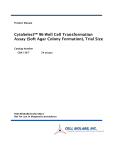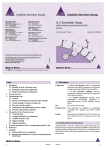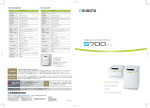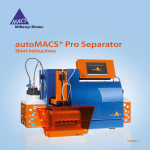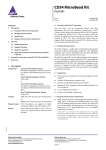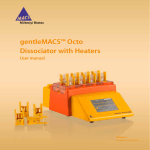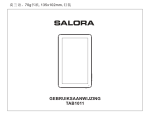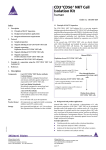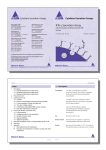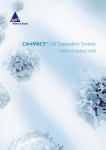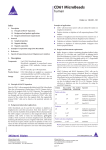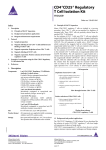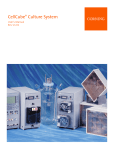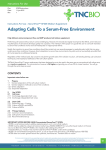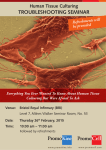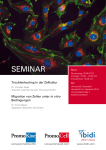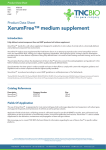Download CD31 MicroBead Kit
Transcript
Miltenyi Biotec GmbH Friedrich-Ebert-Str. 68 51429 Bergisch Gladbach, Germany Phone: +49 2204 8306-0 Fax: +49 2204 85197 [email protected] Miltenyi Biotec Inc. 2303 Lindbergh Street Auburn CA 95602, USA Phone: 800 FOR MACS, +1 530 888 8871 Fax: +1 530 888 8925 [email protected] Miltenyi Biotec Pty. Ltd. (Australia) Phone: +61 2 8877 7400 [email protected] Miltenyi Biotec B. V. (Benelux) [email protected] Customer service, Belgium Phone: 0800 94016 Customer service, Luxemburg Phone: 800 24971 Customer service, Netherlands Phone: 0800 4020120 CD31 MicroBead Kit Miltenyi Biotec Shanghai Office Phone: +86 21 62351005 [email protected] Miltenyi Biotec (France) Phone: +33 1 56 98 16 16 [email protected] for the isolation of human microvascular and umbilical vein endothelial cells (HDMECs, HUVECs) Miltenyi Biotec S.r.l. (Italy) Phone: +39 051 64 60 411 [email protected] Miltenyi Biotec K.K. (Japan) Phone: +81 3 5646 8910 [email protected] Miltenyi Biotec Asia Pacific Pte. Ltd. (Singapore) Phone: +65 6238 8183 [email protected] Miltenyi Biotec Ltd. (UK) Phone: +44 1483 799 800 [email protected] For technical questions, please contact your local subsidiary or distributor. 140-001-341.04 For further information refer to our website www.miltenyibiotec.com Technical Support Team, Germany: Order no. 130-091-935 Miltenyi Biotec S.L. (Spain) Phone: +34 91 512 12 90 [email protected] Unless otherwise specifically indicated, Miltenyi Biotec products and services are for research use only and not for diagnostic or therapeutic use. E-mail: [email protected] Phone: +49 2204 8306-830 1. Description Contents Contents 1. 2. 3. 4. 5. 2 1. Description Description 1.1 Background information 1.2 Product applications Protocols 2.1 Preparation of human dermal microvascular endothelial cells (HDMECs) 2.1.1 Principle of HDMEC purification 2.1.2 Experimental overview 2.1.3 Reagent and instrument requirements 2.1.4 Experimental procedures 2.1.4.1 (Optional) Pre-treatment with Braunol® solution 2.1.4.2 Extraction of HDMECs from foreskin tissue 2.1.5 Harvesting of cultivated cells 2.2 Preparation of human umbilical vein endothelial cells (HUVECs) 2.2.1 Principle of HUVEC purification 2.2.2 Reagent and instrument requirements 2.2.3 Experimental procedures 2.3 CD31 MicroBead Kit purification 2.3.1 Reagent and instrument requirements 2.3.2 Magnetic labeling 2.3.3 Magnetic separation Examples of separations using the CD31 MicroBead Kit 3.1 Separation of HDMECs 3.2 Separation of HUVECs Related products References 140-001-341.04 Components 2 mL CD31 MicroBeads: MicroBeads conjugated to monoclonal anti-human CD31 antibody (isotype: mouse IgG1). 2 mL FcR Blocking Reagent: Human IgG. Capacity For 109 total cells, up to 100 separations. Product format CD31 MicroBeads are supplied as a suspension containing stabilizer and 0.05% sodium azide. Cross-reactivity CD31 MicroBeads are reported to react with rhesus monkey (Macaca mulatta) cells. Storage Store protected from light at 2−8 °C. Do not freeze. The expiration date is indicated on the vial label. 1.1 Background information The CD31 MicroBead Kit has been developed for the isolation of human dermal microvascular endothelial cells (HDMECs) from foreskin biopsies as well as human umbilical vein endothelial cells (HUVECs). CD31, also known as PECAM-1 (platelet endothelial cell adhesion molecule-1), is a single chain, 130 kDa transmembrane glycoprotein that belongs to the immunoglobulin superfamily and mediates cell-to-cell adhesion. CD31 is found constitutively expressed on the surface of microvascular, lymphatic, umbilical cord, and pulmonary capillary endothelial cells, as well as on platelets, monocytes, polymorphonuclear cells, and discrete populations 140-001-341.04 3 2. Protocols 1. Description of lymphocytes1, including CD4+ RTEs (recent thymic emigrants)2. CD31 is central to the transendothelial migration of leukocytes.3 Cell-to-cell interactions via CD31 occur homophilically, with CD38 or with αvβ3 integrin as ligands. CD31 is also involved in angiogenesis.4 Endothelial cells form the layer of thin, flat cells that line the inside of blood vessels, forming a barrier between blood in the vessel lumen and the rest of the vessel wall. In addition to the regulation of transendothelial migration of leukocytes, endothelial cells play a key role in the inhibition of inflammation, thrombosis, vascular smooth muscle proliferation and the promotion of vasodilation by its release of nitric oxide (NO)5. The functional integrity of the endothelium is an important area of cardiovascular research, especially its dysfunction in the formation of atherosclerotic lesions. The isolation of endothelial cells from foreskin biopsies and umbilical cord vein tissue using CD31 MicroBeads permits the in vitro study of highly pure endothelial cell cultures. 1.2 Product applications ● Purification of CD31+ cells, isolated from Rhesus monkey (Macaca mulatta) tissue. 2. Protocols The following section describes the extraction of CD31+ endothelial cells from two different tissue sources for the subsequent purification with CD31 MicroBeads. Dermal microvascular endothelial cells can be extracted from human foreskin biopsies (section 2.1), while venous endothelial cells can be obtained from the umbilical cord (section 2.2). 2.1 Preparation of human dermal microvascular endothelial cells (HDMECs) 2.1.1 Principle of HDMEC purification ● Purification of CD31+ HDMECs, isolated from human foreskin tissue. ● Purification of CD31+ HUVECs, isolated from human umbilical cord tissue. ● Enrichment of HDMECs or HUVECs in fibroblast-contaminated cell cultures. This protocol describes the purification of CD31+ HDMECs from foreskin tissue. Firstly, neutral protease treatment of the biopsy using Dispase II enables the separation and removal of the epidermal layer from the dermis. Once separated, the dermis itself is digested by Collagenase Type 1a to leave a cell suspension containing HDMECs, which are then cultivated for a minimum of 24 hours. Cultivation facilitates an increased purity and yield of CD31+ HDMECs after CD31 MicroBead selection by removal of non-adherent CD31+ cells. ● Purification of other CD31+ cell types, such as CD4+ RTEs after prior untouched enrichment of T cells using the Naive CD4+ T Cell Isolation Kit (# 130-091-894). After treatment of the cultured cells with trypsin, HDMECs, in a single cell suspension, are purified using the CD31 MicroBead Kit. Briefly, CD31+ HDMECs are immunolabeled with CD31 MicroBeads, before 140-001-341.04 4 140-001-341.04 5 2. Protocols 2. Protocols being loaded onto a column placed in the magnetic field of a MACS® Separator. The magnetically labeled CD31+ cells are retained within the column. The unlabeled cells run through; this cell fraction is thus depleted of CD31+ cells. After removing the column from the magnetic field, the magnetically retained CD31+ cells can be eluted as the positively selected cell fraction and directly taken into culture or analyzed for purity by flow cytometry. 2.1.2 Experimental overview Foreskin biopsy (not older than 1 day) Ø Optional: Braunol® treatment for samples with inflammation Ø Dispase II digestion overnight, 4 °C Ø Separation of dermis from epidermis Ø Collagenase Type 1a digestion, 1–2 h 37 °C Ø Filtration of cell suspension (70 μm nylon mesh) Ø Cultivation in EndoGMMV, 24 h Ø Figure 1: Epidermis, dermis, and hypodermis form a three-tiered structure. To access HDMECs within the dermal layer (middle), the epidermis can be removed by peeling the top layer from the dermis and hypodermis. Trypsination Ø HDMEC purification with the CD31 MicroBead Kit 6 140-001-341.04 140-001-341.04 7 2. Protocols 2. Protocols 2.1.3 Pre-treatment with Braunol® solution Reagent and instrument requirements Materials ● Sterile tweezers ● Sterile round-bladed scalpels (e.g. B. Braun Melsungen # 5518083) ● Sterile Petri dish, 100 mm in diameter ● Sterile Petri dish, 60 mm in diameter ● Sterile pipettes ● Sterile 15 mL conical tubes ● Sterile 50 mL conical tubes ● 70 μm nylon cell filter ● T-75 (75 cm2) cell culture flasks Orbital shaker (or MACSmix™ Tube Rotator # 130-090-753) ● Braunol® solution (povidone iodine) (B. Braun Melsungen, # 3864235) ● Sodium thiosulfate (Sigma, # S7026), diluted to 0.05% in Hepes buffered saline solution (HepesBSS) (e.g. PromoCell, # C-40020) ● Phosphate buffered saline (PBS) without Ca+ or Mg+ Reagents for enzymatic digestion and HDMEC extraction Lab equipment ● Centrifuge ● Laminar flow hood (biohazard containment hood) ● CO2 incubator, 37 °C with 5% CO2 in air and >95% humidity ● Microscope, hemocytometer ● Water bath (37 °C) ● Dispase II (Roche Diagnostics, # 295825) ● Collagenase Type 1a (Sigma, # C2674), diluted to 0.25% in 2 mM CaCl2/HepesBSS ● HepesBSS ● Endothelial Cell Growth Medium MV (EndoGMMV) (PromoCell, # C-22020) Reagents for HDMEC culture step 140-001-341.04 8 ● ● Endothelial Cell Growth Medium MV (EndoGMMV) (PromoCell, # C-22020) ● PBS without Ca+ or Mg+ ● Trypsin/EDTA (PromoCell # C-41010) ● Trypsin Neutralizing Solution (PromoCell # C-41100) ● Trypan blue 140-001-341.04 9 2. Protocols 2. Protocols 2.1.4 7. Experimental procedures 2.1.4.1 (Optional) Pre-treatment with Braunol® solution 8. ▲ A pre-treatment step in order to disinfect the foreskin biopsy using Braunol® solution is strongly recommended. Also, foreskin biopsies may contain inflamed regions upon assessment. Should large, inflamed regions be observed then Braunol treatment is mandatory. Perform all steps within a laminar flow hood. 1. Wash once more for 5 min with agitation in a second tube of 15 mL PBS. Store the biopsy in 20 mL of HepesBSS until further use. ▲ Note: Keep storage time of biopsies to an absolute minimum as cell viability decreases rapidly over time, resulting in a lower yield of HDMECs after CD31 MicroBead isolation. Do not store biopsies overnight or for 1 day before proceeding to the extraction step. 2.1.4.2 Extraction of HDMECs from foreskin tissue For an illustrated short protocol please visit www.miltenyibiotec.com/ protocols. HDMECs should be extracted from foreskin biopsies that are as fresh as possible, and not older than 1 day. The quantity of HDMECs recovered is severely affected in biopsies older than 1 day, to the degree of a 10-fold reduction in a 5-day old sample. Prepare 5×50 mL conical tubes containing: 10 mL Braunol solution 15 mL PBS 15 mL PBS 15 mL HepesBSS/0.05% sodium thiosulfate 20 mL HepesBSS 2. Immerse the tissue biopsy into Braunol solution using sterile tweezers. 3. Incubate the tube at room temperature for 10 min on an orbital shaker (or MACSmix Tube Rotator). 4. Transfer the biopsy to 15 mL of PBS and incubate for a further 5 min with agitation. 5. Transfer the biopsy to the tube containing 15 mL of HepesBSS/0.05% sodium thiosulfate using sterile tweezers. 6. Incubate for 5 min at room temperature on an orbital shaker (or MACSmix Tube Rotator). 10 140-001-341.04 1. Prepare a sterile petri dish (60 mm in diameter) with 5–6 mL of Dispase II solution per foreskin biopsy being prepared. 2. Place the biopsy in a second petri dish (100 mm in diameter), assess for inflammation and cut away infected or damaged areas with a sterile scalpel, followed by treatment with Braunol solution (see 2.1.4.1). 3. Orientate the biopsy so that the epidermal side (smooth surface) is facing upwards. ▲ Note: Orientation in this fashion is to facilitate the easier handling of the biopsy when cutting with a scalpel, as grip is achieved between the underside and the dish, in contrast to that of the smooth epidermal side. 140-001-341.04 11 2. Protocols 2. Protocols 4. Identify the inner and outer sides of the foreskin (the inside is a lighter color than the outside). Separate the two sides by carefully cutting between them with a round-bladed scalpel. 11. Apply 5 mL of pre-warmed (37 °C) Collagenase Type 1a solution and close the tube. Incubate for 75 min (maximum) in a 37 °C waterbath. Shake vigorously every 30 min. ▲ Note: Foreskin biopsies can be cut easier and cleaner by using short, measured steps and with a back and forth rocking motion. A clean cut will later facilitate a simpler separation of the epidermis from the dermis (step 9). ▲ Note: (Optional) Seal the tube with Parafilm to ensure that there is no contamination or sample loss. ▲ Note: After digestion, the cell suspension should be slightly viscous, though it is normal to still observe undigested parts of skin tissue. 5. Carefully subdivide both pieces into smaller pieces of approximately 4–5 mm2. 6. Place all the pieces into the pre-prepared petri dish containing Dispase II, with the epidermal side facing downwards. 12. Dilute the cell suspension with 10 mL of EndoGMMV and pass through a 70 μm nylon filter, which is placed over the opening of a 50 mL conical tube. ▲ Note: Orienting the tissue with the epidermal side facing downwards is very important in order to achieve an adequate separation of dermis from epidermis. 13. Centrifuge filtrate at 300×g for 3–5 min. Aspirate supernatant. 7. Incubate for 12–24 h at 4 °C. 14. Resuspend pellet carefully in 1 mL of EndoGMMV. 8. After the incubation, prepare a 15 mL conical tube with 10 mL of HepesBSS. 15. Place cells into a T-75 (75 cm2) culture flask and add a further 20 mL 9. Separate the dermis from the epidermis: carefully peel back the epidermal layer of all the pieces using sterile tweezers (epidermis can be differentiated easily by its darker coloration and wafer-like appearance – see diagram on page 6). 16. Culture the cells at 37 °C, 5% CO2 and >95% humidity for a minimum of 24 h before purification with CD31 MicroBead Kit. 10. Collect the dermal layers in the 10 mL of HepesBSS. Let the pieces settle to the bottom before aspirating the supernatant. ▲ Note: A small volume of supernatant remaining in the tube will not disturb the subsequent collagenase digest. 140-001-341.04 12 of EndoGMMV. ▲ Note: Endothelial cells become identifiable after 24 h in culture, and prolonged culture will increase yield of CD31+ cells after CD31 MicroBead Kit isolation. However, growth of fibroblasts will also occur simultaneously and care must be taken to monitor for their overgrowth. Therefore, it is advised not to culture cells for longer than 3 days. 17. Proceed to purification of CD31+ cells using the CD31 MicroBead Kit (see 2.3). 140-001-341.04 2. Protocols 2. Protocols 2.1.5 Harvesting of cultivated cells 2.2 Preparation of human umbilical vein endothelial cells (HUVECs) ▲ For the isolation of CD31+ HDMECs, cells are first trypsinized and then counted before proceeding to the CD31 MicroBead purification of HDMECs. Cell confluency should optimally be 60–80% at time of harvesting, resulting in a total yield of approximately 3–5×106 cells per foreskin biopsy, of which around 3–5×105 are CD31+. 1. Remove culture supernatant and wash cells once with PBS to remove residual medium. 2. Add 100 μL of Trypsin/EDTA (PromoCell) per cm2 of cultured cells and incubate at room temperature for several minutes. ▲ Note: Incubation conditions for trypsinization may vary according to manufacturer of trypsin. Always follow manufacturer’s guidelines if different to those above. 3. Check under a microscope that the cells are completely dissociated. If not, gently tap flask on the bench or prolong incubation time. ▲ Note: Avoid over-trypsinization of cells. 4. Once cells are detached, add 100 μL of Trypsin Neutralizing Solution per cm2 of cultured cells. Resuspend cells and transfer them to a 15 mL conical tube. 5. Centrifuge cells at 300×g for 3 min. 6. Resuspend cells thoroughly in 1–2 mL of medium. 7. Count cells using a hemocytometer. 8. Proceed with 2.3 CD31 MicroBead Kit purification. 14 13 140-001-341.04 2.2.1 Principle of HUVEC purification This protocol describes the purification of CD31+ HUVECs from umbilical cord tissue. After removing blood from the outside of the umbilical cord, both ends as well as damaged tissue caused by the clamping of the ends should be removed. Next, all blood within the umbilical vein is thoroughly, but carefully, washed out before injecting trypsin into the umbilical cord vein in order to release the endothelial cells. After an incubation period, trypsinized HUVECs are then collected by eluting the contents of the cord vein and are directly centrifuged to remove the trypsin before proceeding with the isolation of CD31+ cells using the CD31 MicroBead Kit (see section 2.3). Briefly, CD31+ HUVECs are immunolabeled with CD31 MicroBeads, before being loaded onto a column placed in the magnetic field of a MACS Separator. The magnetically labeled CD31+ cells are retained on the column. The unlabeled cells run through and this cell fraction is depleted of CD31+ cells. After removal of the column from the magnetic field, the magnetically retained CD31+ cells can be eluted as the positively selected cell fraction and directly taken into culture or analyzed for purity by flow cytometry. 140-001-341.04 15 2. Protocols 2. Protocols 2.2.2 Reagents Reagent and instrument requirements ● Materials ● ● ● ● ● ● ● ● ● ● ● 500 mL glass beaker Sterile tweezers Sterile scalpel Sterile 20 mL syringe Sterile Gavage Feeding Needles (Fine Science Tools # 18061-20) Sterile clamps (e.g. Carl Roth # N141.1) Double Dead Ender Cap, male (Qosina # 65802) Sterile 50 mL conical tubes T-75 (75 cm2) cell culture flasks ● ● 2.2.3 ● ● ● Experimental procedures ▲ As with the isolation of HDMECs from foreskin, umbilical cords should be thoroughly scrutinized for sites of damage which must be removed before the endothelial cell isolation procedures are started. Intact umbilical cords should be at least 12 cm long. Perform all steps within a laminar flow hood. 1. Lab equipment ● PBS (without Ca+ or Mg+) HepesBSS/6 mM EDTA Trypsin/EDTA (Invitrogen # 25300-054) Trypan blue Fetal bovine serum (FBS) Centrifuge Laminar flow hood (biohazard containment hood) Microscope, hemocytometer Water bath (37 °C) To remove injured ends of the cord, or the damage caused by clamping, cut neatly on the interior side of the injury with a scalpel and at a distance of at least 1 cm. ▲ Note: To obtain a neat, straight cut, grip the cord with a pair of sterile tweezers and lead the scalpel along the inside line of the tweezers, cutting carefully. 2. At one end, insert a feeding needle carefully into the vein without damaging the surrounding tissue. Fix in place with clamp. ▲ Note: The umbilical vein can be easily recognized as it is the vessel with the largest diameter. 140-001-341.04 16 140-001-341.04 17 2. Protocols 2. Protocols 3. 4. 5. Fill a 20 mL syringe with HepesBSS/6 mM EDTA and rinse the vein via the feeding needle until no remnants of blood are visible in the eluate. 13. Remove cap from opposite end, carefully flush the cord with Hepes/ EDTA and collect all effluent in the conical tube containing the FBS. The eluate should be cloudy with flakes of cellular material. ▲ Note: CD31 is expressed on certain populations of blood cells as well as platelets. Thorough washing ensures minimal contamination after CD31 MicroBead Kit purification. 14. Centrifuge eluate at 300×g for 5 min at room temperature. Insert a second feeding needle into the vein at the other end of the cord and fix with forceps. Check for a continuous flow from this end by rinsing the vein once more with HepesBSS/6 mM EDTA. Fill a second syringe with 5 mL of Trypsin/EDTA (Invitrogen), prewarmed to 37 °C, and replace the first syringe without the formation of air bubbles. 6. Inject 4.5 mL of the Trypsin/EDTA (Invitrogen). 7. Before injecting the last 0.5 mL, seal the opposite end with a Double Dead Ender Cap to prevent collapse of the vein. 8. Suspend the cord in a U-shape in the 500 mL beaker with PBS prewarmed to 37 °C. 9. Incubate for 20 min at 37 °C. 15. Resuspend cells well in 1 mL of PBS and count viable cells by Trypan blue exclusion in a hemocytometer. 16. Proceed directly to purification of CD31+ cells using the CD31 MicroBead Kit (see 2.3 CD31 MicroBead Kit purification). 2.3 CD31 MicroBead Kit purification ▲ For the purification of HDMECs, EndoGMMV should be used throughout the procedure. Similarly, EndoGM should be used for HUVEC purification. 2.3.1 ● ● 10. Place the cord on a soft surface (e.g. tissue paper) and carefully massage for 5 min with two fingers. ● 11. Put 2 mL of FBS into a 50 mL conical tube. 12. Fill a syringe with 8 mL of HepesBSS/6 mM EDTA and attach without letting air bubbles in. 18 140-001-341.04 ● Reagent and instrument requirements LS Column MidiMACS™ Separator (Optional) Fluorochrome-conjugated antibody for flow cytometric analysis, for example, CD31-PE (# 130-092-653), CD31-APC (# 130092-652), CD45-FITC (# 130-080-202), CD34-PE (# 130-081-002), CD34-APC (# 130-090-954). (Optional) Propidium iodide (PI) or 7-AAD for flow cytometric exclusion of dead cells. 140-001-341.04 19 2. Protocols 2. Protocols ● (Optional) Pre-Separation Filters (# 130-041-407) to remove cell clumps. 2.3.3 Magnetic separation Magnetic separation with LS Columns 2.3.2 Magnetic labeling ▲ Volumes given are for up to 1×107 cells. When working with fewer than 1×107 cells, use the same volumes as indicated. When working with higher cell numbers, scale up all reagent volumes and total volumes accordingly (e.g. for 2×107 total cells use twice the volume described). 1. Place an LS Column in the magnetic field of a MidiMACS Separator. 2. Prepare column by rinsing with 3 mL of medium. 3. Apply cell suspension onto the column. 4. Collect unlabeled cells which pass through and wash column with 3×3 mL of medium. Perform washing steps by adding medium three times. Only add new medium when the column reservoir is empty. Collect total effluent; this is the unlabeled cell fraction. 1. Centrifuge cells at 300×g for 3 min. Aspirate supernatant completely. 2. Resuspend cells to a maximum concentration of 1×107 cells per 60 μL of medium. 5. Remove column from the separator and place it on a suitable collection tube. 3. Add 20 μL of FcR Blocking Reagent per 1×107 cells. Vortex briefly, then add 20 μL of CD31 MicroBeads to the mixture. 6. Pipette 5 mL of medium onto the column. Immediately flush out the magnetically labeled cells by firmly pushing the plunger into the column. 4. Incubate 15 min at 4 °C. 7. 5. Add 1 mL of medium per 1×107 and centrifuge cells at 300×g for 3 min. Cells can be directly analyzed by flow cytometry for purity or taken into culture. Resuspend the cell pellet in 1 mL of medium. 7. Proceed to magnetic separation (see 2.3.2). For HUVECs, yield of CD31+ cells will depend upon cord length and efficiency of enzyme digestion. 140-001-341.04 20 140-001-341.04 21 3. Examples of separations using the CD31 MicroBead Kit 2. Protocols Magnetic separation with the autoMACS® Separator ▲ Refer to the autoMACS® user manual for instructions on how to use the autoMACS Separator. 1. Prepare and prime autoMACS Separator. 2. Place tube containing the magnetically labeled cells in the autoMACS Separator. For a standard separation, choose one of the following separation programs: Positive selection: "Possel" Depletion: "Depletes" ▲ Note: Program choice depends on the isolation strategy, the strength of magnetic labeling and the frequency of magnetically labeled cells. For details see autoMACS user manual, section autoMACS Cell Separation Programs. 3. 3. Examples of separations using the CD31 MicroBead Kit 3.1 Separation of HDMECs Separation of CD31+ HDMECs from a preparation of dermal-layer cells of human foreskin using CD31 MicroBeads and a MidiMACS Separator with an LS Column. The cells are fluorescently stained with CD31-APC (# 130-092-652). Cell debris and dead cells were excluded from the analysis based on scatter signals and PI fluorescence. HDMECs before separation CD31-APC CD31+ cells CD31- cells Relative cell number ▲ Note: Should fibroblast contamination outgrow endothelial cells upon prolonged cultivation, endothelial cells should be re-purified using CD31 MicroBeads, or alternatively fibroblasts can be removed using Anti-Fibroblast MicroBeads (# 130-050601). Relative cell number Cells should be seeded at a density of approximately 150,000 per T-75 flask. Culture conditions: 37 °C, 5% CO2 and >95% humidity. Relative cell number 6. For HDMECs, yield of CD31+ cells depends upon the size and thickness of foreskin used. Generally, cells isolated from a single, 4 cm2 biopsy should be cultured in one T-75 flask. CD31-APC CD31-APC When using the program "Possel", collect positive fraction from outlet port pos1. This is the purified positive cell fraction. When using the program "Depletes", collect unlabeled fraction from outlet port neg1. This is the negative cell fraction. 22 140-001-341.04 140-001-341.04 23 3. Examples of separations using the CD31 MicroBead Kit 3. Examples of separations using the CD31 MicroBead Kit 3.2 Separation of HUVECs Separation of CD31+ HUVECs, prepared from a human umbilical cord, using CD31 MicroBeads and a MidiMACS Separator with an LS Column. The cells are fluorescently stained with CD31-APC (# 130-092-652) and CD45-PE (# 130-080-201), a marker to indicate leukocyte contamination. CD45+/CD31+ double-positive cells in the positive fraction reflect the insufficient removal of blood from the cord. Cell debris and dead cells were excluded from the analysis based on scatter signals and PI fluorescence. Before separation CD31+ cells CD31- cells CD31-APC 140-001-341.04 24 CD45-PE CD45-PE CD45-PE Figure 2: Cultured HDMECs after extraction from foreskin tissue and purification using the CD31 MicroBead Kit. CD31-APC CD31-APC 140-001-341.04 25 4. Related products All protocols and data sheets are available at www.miltenyibiotec.com. 4. Related products CD31-PE, human 130-092-653 CD31-APC, human 130-092-652 CD34-FITC, human 130-081-001 CD34-PE, human 130-081-002 CD34-APC, human 130-090-954 CD45-FITC, human 130-080-202 CD45-PE, human 130-080-201 Anti-Fibroblast MicroBeads, human 130-050-601 MACSmix Tube Rotator 130-090-753 Reagents contain sodium azide. Under acidic conditions sodium azide yields hydrazoic acid, which is extremely toxic. Azide compounds should be diluted with running water before discarding. These precautions are recommended to avoid deposits in plumbing where explosive conditions may develop. Warranty The products sold hereunder are warranted only to be free from defects in workmanship and material at the time of delivery to the customer. Miltenyi Biotec GmbH makes no warranty or representation, either expressed or implied, with respect to the fitness of a product for a particular purpose. There are no warranties, expressed or implied, which extend beyond the technical specifications of the products. Miltenyi Biotec GmbH’s liability is limited to either replacement of the products or refund of the purchase price. Miltenyi Biotec GmbH is not liable for any property damage, personal injury or economic loss caused by the product. Unless otherwise specifically indicated, Miltenyi Biotec products and services are for research use only and not for diagnostic or therapeutic use. 5. References 1. DeLisser, H. M. et al. (1994) Molecular and functional aspects of PECAM-1/CD31. Immunol. Today. 15: 490–495. 2. Kimmig, S. et al. (2002) Two subsets of naive T helper cells with distinct T cell receptor excision circle content in human adult peripheral blood. J. Exp. Med. 195: 789–794. 3. Muller, W. A. et al. (1993) PECAM-1 is required for transendothelial migration of leukocytes. J. Exp. Med. 178: 449–460. 4. Bird, I. N. et al. (1999) Homophilic PECAM-1 (CD31) interactions prevent endothelial cell apoptosis but do not support cell spreading or migration. J. Cell. Sci. 112: 1989– 1997. 5. Behrendt, D. and Ganz, P. (2002) Endothelial function. From vascular biology to clinical applications. Am. J. Cardiol. 90: 40L–48L. 26 Warnings 140-001-341.04 autoMACS and MACS are registered trademarks of Miltenyi Biotec GmbH. MidiMACS, MiniMACS, OctoMACS, QuadroMACS, SuperMACS, VarioMACS, and MACSmix are trademarks of Miltenyi Biotec GmbH. Braunol is a registered trademark of B. Braun Melsungen AG. Copyright © 2010 Miltenyi Biotec GmbH. All rights reserved. 140-001-341.04 27







